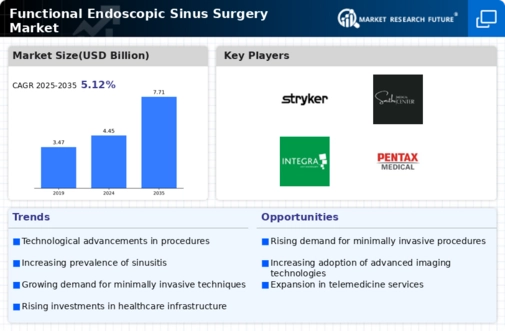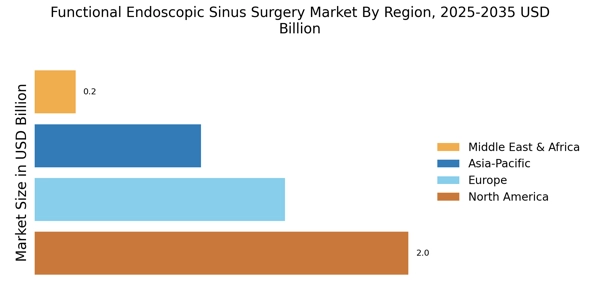Growing Geriatric Population
The aging population is a significant factor driving the Functional Endoscopic Sinus Surgery Market. As individuals age, they become more susceptible to sinus-related issues, including chronic sinusitis and nasal obstruction. The World Health Organization projects that the number of people aged 60 years and older will double by 2050, leading to an increased demand for surgical interventions. This demographic shift is likely to result in a higher incidence of sinus surgeries, as older adults often seek relief from chronic conditions that affect their quality of life. Consequently, the Functional Endoscopic Sinus Surgery Market is expected to grow in response to the needs of this expanding patient population.
Rising Incidence of Sinusitis
The increasing prevalence of sinusitis is a primary driver for the Functional Endoscopic Sinus Surgery Market. Sinusitis affects millions of individuals worldwide, leading to a growing demand for effective treatment options. According to health statistics, approximately 29 million adults in the United States are diagnosed with chronic sinusitis annually. This condition often necessitates surgical intervention when conservative treatments fail. As awareness of the condition rises, more patients seek surgical solutions, thereby propelling the market forward. The Functional Endoscopic Sinus Surgery Market is likely to experience growth as healthcare providers recommend surgery for patients with persistent symptoms, indicating a shift towards more aggressive treatment approaches.
Increased Healthcare Expenditure
Rising healthcare expenditure across various regions is contributing to the growth of the Functional Endoscopic Sinus Surgery Market. As healthcare systems evolve, there is a greater allocation of resources towards advanced surgical procedures. Increased funding for healthcare services allows for the adoption of innovative surgical technologies and techniques, which enhances the overall quality of care. Moreover, patients are more willing to invest in their health, leading to a higher demand for elective surgeries, including functional endoscopic sinus surgery. This trend suggests that the Functional Endoscopic Sinus Surgery Market will continue to thrive as healthcare investments increase, facilitating access to necessary surgical interventions.
Advancements in Surgical Techniques
Technological innovations in surgical techniques are significantly influencing the Functional Endoscopic Sinus Surgery Market. The introduction of advanced imaging technologies, such as 3D endoscopy and navigation systems, enhances the precision of sinus surgeries. These advancements not only improve patient outcomes but also reduce recovery times, making surgery a more appealing option for patients. The market is projected to expand as these technologies become more widely adopted in surgical practices. Furthermore, the integration of robotic-assisted surgery is anticipated to revolutionize the Functional Endoscopic Sinus Surgery Market, offering surgeons enhanced control and visualization during procedures, which could lead to better surgical results.
Enhanced Patient Education and Awareness
The rise in patient education and awareness regarding sinus health is a crucial driver for the Functional Endoscopic Sinus Surgery Market. As patients become more informed about their health conditions, they are more likely to seek medical advice and consider surgical options. Educational campaigns and resources provided by healthcare professionals have empowered patients to understand the benefits of functional endoscopic sinus surgery. This increased awareness is likely to lead to higher consultation rates and, subsequently, more surgical procedures. The Functional Endoscopic Sinus Surgery Market stands to benefit from this trend, as informed patients actively pursue treatment options that can alleviate their symptoms and improve their quality of life.


















Leave a Comment